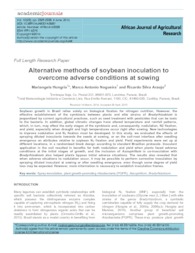Alternative methods of soybean inoculation to overcome adverse conditions at sowing.
Alternative methods of soybean inoculation to overcome adverse conditions at sowing.
Author(s): HUNGRIA, M.; NOGUEIRA, M. A.; ARAUJO, R. S.
Summary: Soybean growth in Brazil relies solely on biological fixation for nitrogen nutrition, However, the effective establishment of the symbiosis between plants and elite strains of Bradyrhizobium is jeopardized by current agricultural practices, such as seed treatment with pesticides that can be toxic to the bacteria. In addition, global climatic changes have altered temperature and rainfall patterns, which, in turn, may affect the early stages of the symbiosis and, consequently, nodulation, N2 fixation, and yield, especially when drought and high temperatures occur right after sowing. New technologies to improve nodulation and N2 fixation must be developed. In this study, we evaluated the effects of spraying diluted inoculants towards the seeds at sowing, or on the soil-root interface after seedling emergence on attributes relative to soybean N2 fixation and yield. Field experiments were set up at different locations, in a randomized block design according to standard Brazilian protocols. Inoculant application in the soil resulted in benefits for both nodulation and yield when plants faced adverse conditions at the initial stages of growth, and the inclusion of Azospirillum in co-inoculation with Bradyrhizobium also helped plants bypass initial adverse situations. The results also revealed that when adverse situations to nodulation occur, it may be possible to perform corrective inoculation by spraying diluted inoculant at sowing or after seedling emergence, even though some degree of yield loss may be expected. However, more information is necessary to establish inoculation frames.
Publication year: 2015
Types of publication: Journal article
Unit: Embrapa Soybean
Keywords: Fixação de nitrogênio, Inoculante, Nitrogen fixation, Soja, Soybeans
Observation
Some of Embrapa's publications are published as ePub files. To read them, use or download one of the following free software options to your computer or mobile device. Android: Google Play Books; IOS: iBooks; Windows and Linux: Calibre.
Access other publications
Access the Agricultural Research Database (BDPA) to consult Embrapa's full library collection and records.
Visit Embrapa Bookstore to purchase books and other publications sold by Embrapa.

